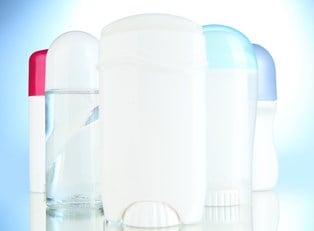Many Americans suffer from red, itchy rashes in the underarm region. This axillary skin is an area particularly susceptible to skin irritation for many reasons. The deodorant and antiperspirant applied to these tender areas contain many irritants. Secondly, the moisture and warmth caused by perspiration creates an environment in which bacteria can thrive. Additionally, the arms, engaged in continual motion throughout the day, facilitate friction between the skin and clothing, which may cause or worsen an underarm irritation.
Cosmetics are a major cause of skin irritation or contact allergies, and they often result in irritant contact dermatitis, which is when your skin, inflamed and irritated, develops a red rash. You may not have realized that your deodorant is classified as a cosmetic by the Federal Drug Administration (FDA). According to the FDA, cosmetics are products that are applied to the body for the intended use of cleansing, beautifying, promoting attractiveness, or altering the appearance. Deodorant is one cosmetic with a big reputation for irritating armpits.
If you have a rash or are prone to underarm irritation, then you will want to pinpoint the source of your skin’s reaction and discontinue use immediately. You may also want to apply corticosteroid cream to the affected area to relieve your symptoms. If your rash spreads, does not improve, or is severe, then you should check with your doctor for other treatment options. Avoiding products with the following ingredients may be recommended:
- Aluminum
Deodorants that are combined with antiperspirants contain aluminum compounds, which frequently cause contact allergies. Aluminum is the active ingredient found in antiperspirant and works to prevent perspiration altogether. If your skin cannot tolerate these aluminum derivatives, you may be stuck with using deodorant only. - Fragrance
Perhaps the biggest reason why cosmetics irritate the skin is because of fragrance. Fragrance is the most common skin offender found in cosmetics, according to the National Institutes of Health. Since deodorants try to suppress body odor, they contain generous amounts of it. Commonly used fragrances are perfumes, essential oils, and balsam of Peru. - Alcohol
By design, deodorants mainly cover up unwanted odor with a preventative approach. Since it is the bacteria living on your skin that metabolize your sweat and produce body odor, deodorants include ingredients that work to kill or neutralize your bacteria. No bacteria means no body odor. As a result, your deodorant may contain alcohol, which has antimicrobial properties. Your skin may react right away to alcohol, or it can dry out over time, leading to a breakdown of your skin barrier and making rashes a more likely occurrence.
Additionally, your deodorant may also contain phthalates, parabens, or lanolin, also common irritants. Finding tolerable deodorant alternatives can be difficult when the list of contents to avoid is so long. Some with sensitive skin revert to homemade alternatives containing baking soda and cornstarch. Unfortunately, there is no alternative for antiperspirant, so addressing odor will be your only option when making or buying these milder forms of deodorant.



